Displaying items by tag: Royal St George Yacht Club
Dun Laoghaire Motor Yacht Club Frostbites Cancelled
Despite the modest seascape of the above photograph today's Frostbites in Dun Laoghaire have been cancelled writes Cormac Bradley. The weather station adjacent to where this photo was taken was recording 18 knots of wind with a highest gust of 33 knots from the West.
Elsewhere in the harbour, the keelboats moored between Hell's Gates and DMYC were swinging through 90 degrees when they were hit by squalls on the water.
At various intervals, Dublin Bay has disappeared under rain clouds.
Next Saturday night, the Royal St George Yacht Club hosts a celebration of 50 years of Fireballing in Ireland. The great, the good and a big crowd of over 200 are expected.
Fireball Sailors Are Reeling in the Years – 50 Year Reunion at Royal St. George Yacht Club
Fireball sailors are reeling in the years next Saturday (6th February) night when they stage a fifty year reunion of the international class at the Royal St. George Yacht Club in Dun Laoghaire.
The 16–foot dinghy class, for so long a mainstay of the small boat scene here, has a list of members and former members that reads like a who's who of Irish sailing.
Organisers have put out a call for memorabilia as the gathering aims to feature people, fleets and activities from five decades.
Over 200 are expected on the night. And it's not too late to join them. There's a last shot out for final bookings but they must be made by tonight. Click here for more.
Any archive material for display on the night can be sent to [email protected]
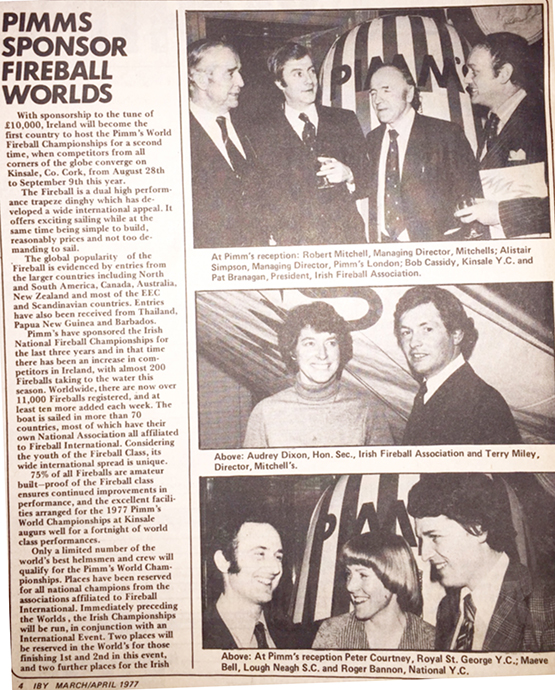
Blast from the past – memories of World Championship preparations from 1977
Cat-as-Trophy On The Road To Kinsale...?
If you live outside the goldfish bowl which is the International Dragon Class and Dun Laoghaire sailing, you may not have heard that the ginger cat which is resident in the Royal St George Yacht Club had become so fond of spending time in Martin Byrne’s Dragon in the club boat-park that it almost went to Kinsale reports WM Nixon.
Seems that former RStGYC Commodore Byrne hitched up his Dragon without a care in the world to head for Kinsale and the South Coast Championship last month. And everything went smoothly until he was well through the Dublin suburbs, when a guy pulled up alongside him at traffic lights, and asked if he always travelled with a ginger pussy on top of his boat.
The bould Martin gingerly (how else?) headed back to the club, and returned one agitated feline to its home base, then headed off for Kinsale again. But by this time, the Gardai had been alerted and the boys in blue were determined to get their moneysworth. So when the Byrne Dragon equipe pulled up at a police check on the road to Cork, didn’t he have to tell the whole story of how the cat was no longer in the ship’s company before he could go on his way?
And by the time he got to Kinsale, hadn’t the multi-talented Rob Jacob been on the case, and the resulting cartoon was already going the rounds. Even the coolest skipper can be put off his stride when one thing after another is piled like this into the way of his smooth progress. So although Martin Byrne may have won the renowned Edinburgh Cup in the International Dragon Class in times past, in Kinsale a fortnight ago he didn’t even get a podium place. But we’re assured the RStGYC cat is purring along very nicely, thank you.
#dlregatta – As well as winning the 'Volvo Boat of the week award' with George Sisk's offshore performance in Wow, the Royal Irish Yacht Club topped the leaderboard of Dun Laoghaire's waterfront clubs with eight wins across IRC and one designs at yesterday's Volvo Dun Laoghaire Regatta. The club took wins in IRC One, IRC Four, J109, White Sails Two, Dragon, Beneteau 21 and Mermaid. Significantly, the RIYC won two of three national Championships being sailed as part of the extensive 29 class regatta programme. ICRA divison one champion, John Maybury's Joker II came from behind yesterday afternoon to win the J109 Irish title after a battle with Howth Yacht Storm in an 11-boat fleet. Séamus Storan's Capilano of the RIYC overhauled a Scottish entry to win in a 13-boat Beneteau 21 fleet.
As well as boat of the week, the Royal Irish also won VDLR's 'Best Overall IRC Yacht' with an impressive performance by club–quarter tonner Cri–Cri skippered by Paul Colton in IRC four. Paul O'Higgin's Rockabill V took the final advantage yesterday to take IRC one from overnight leader Tony Fox's A35 Gringo of the National Yacht Club who suffered from a premature start.
Neighbours at the Royal St. George YC were not far behind in the winning stakes. The George won in seven classes of the one design divisions from Beneteau 31.7 keelboats to GP14 dinghies. The National Yacht Club had five class victories; White Sails one, Flying Fifteen, SB20, Shipman and Moth.
The event that is organised by all four Dun Laoghaire waterfront clubs is being hailed a huge success both afloat and ashore. Although 180 visiting boats, made up nearly half the fleet, yachts from outside the bay area took away only seven trophies. The bulk of the silverware – 17 titles – have stayed on Dun Laoghaire's waterfront.
{youtube}uZ4s5SUf1nE{/youtube}
#dlregatta – With the Kinsale ICRA Nats/Sovereigns Trophy 2015 very successfully concluded last weekend, and a classic Dun Laoghaire to Dingle Race put stylishly in place before that, the feeling of another sailing summer busily in progress is all-pervasive. But while the image projected may well be one of stately progress by the cruiser-racer fleets along the Irish coast, taking in an offshore race here and a regatta there with much leisurely cruising in between, the reality is usually otherwise. For those boats doing significant segments of the programme, it's a case of fitting chosen events into the usual hectic early summer life of work and family commitments and exams and everything else, with the re-location of boats to the next venue being a hurried task undertaken by delivery crews.
Next week sees the mid-season peak of the sailing summer, with the four day Volvo Dun Laoghaire Regatta 2015 in Dublin Bay from Thursday July 9th to Sunday July 12th. In a way it is an amalgamation of all that has has already occurred in this year's season, together with new elements to make it a unique sailfest which celebrates the fact that the citizens of Ireland's capital city and their guests can be conveniently sailing and racing within a very short distance of the heart of town. W M Nixon sets the scene
In the dozen or so years since its inception, the biennial Volvo Dun Laoghaire Regatta has settled itself firmly into the sailing scene as an exceptionally varied event in terms of the boats and classes taking part. There are five regular cruiser-racer classes, plus an offshore division, fourteen one design keelboat classes, and nine dinghy classes. And although there are contenders from Ireland's north coast and from the Cork area and south coast too, together with one gallant entry from Galway, it is essentially an Irish Sea Sailfest, though with a remarkably strong Scottish presence.
However, it was on the coast of Wales at 8.0pm last night that this sailing celebration began, with an ISORA Race starting in Holyhead and heading for Dun Laoghaire to set this large and complex programme into action towards a culmination on Dublin Bay in eight days time with the conclusion of VDLR2015.
2015 marks the Bicentennial of the Royal Dee YC, which was founded in 1815 on the Cheshire shores of the River Dee estuary where northwest England marches with northeast Wales. Originally the Dee Yacht Club (and founded, it's said, a month or two before the Royal Yacht Squadron came into being in the south of England, making the RDYC the second-oldest Royal yacht club in England after the Royal Thames), the Cheshire club became the Royal Dee YC in 1847.
Although the great prosperity of Liverpool in the 19th century saw the club's fleet of substantial yachts gathered in the Dee and then increasingly in the Mersey, by the late 1900s it was looking to the Menai Straits area as the focus of its keelboat events. As well, the completion of Holyhead breakwater in 1873 added a new and important harbour to its list of possible big boat sailing locations, and there was an increase in the number of cross-channel "matches" which the Royal Dee and the Royal Mersey, in conjunction with the Dublin Bay clubs, had already been running for some years.

A Royal Alfred YC cross-channel match from Dublin Bay to Holyhead gets under way in 1888. Cross-channel links were strong in the latter half of the 19th Century, and with the new breakwater completed at Holyhead in 1873, a new venue was available both for the Irish clubs and those on the other side such as the Royal Dee and the Royal Mersey

The bicentenary logo of the Royal Dee YC. In 1815, this club on the Cheshire coast was founded shortly before the Royal Yacht Squadron in the souh of England, whose Bicentennial is being celebrated at the end of July.

Dun Laoghaire saw its first regatta staged in 1828, and participation by yachts from the northwest of England and North Wales was regularly recorded. This is the Royal St George YC regatta of 1871.
So when we say that the Royal Dee has always been a stalwart of offshore racing in the Irish Sea, we're not referring to a story spanning only the 20th and 21st Centuries. On the contrary, it goes well back into the 1800s. And now, with the revival of keelboat sailing in the Mersey with several of Liverpool's myriad docks being given over to recreational use, we have in a sense come full circle with enthusiastic Dublin Bay support of the Bicentennial celebrations reflecting sailing links which go back almost 200 years
The Lyver Trophy is the Royal Dee's premier offshore challenge, and this year it is special, as it's a fully-accredited RORC event counting for points in the annual championship, and a highlight of the ISORA Programme 2015. It's start scheduled for yesterday evening in Holyhead will see the fleet – mostly regular ISORA contenders – sail a course of at least a hundred miles before finishing in Dun Laoghaire. Then as VDLR 2015 gets under way, races in it, combined with the Lyver Trophy results, will count as part of a series towards finding an overall winner of the RDYC Bicentennial Trophy.
Only entrants in the Lyver Trophy race are eligible, and for that race itself – which can be followed on the Averycrest Yellowbrick Tracker - the favourite has to be the Shanahan family's J/109 Ruth, still buoyed up by her great victory in the Dun Laoghaire to Dingle Race three weeks ago.

Back in The Bay – the Shanahan family's J/109 Ruth will be back in her home waters of Dublin Bay after winning the Dun Laoghaire to Dingle Race and completing the Lyver Trophy Race from Holyhead which started last night. Photo: David O'Brien
At the other end of the size scale, the VDLR2015 Dublin Bay programme includes several dinghy classes, and the biggest fleet will be mustered by the International GP 14s, who have designated the racing in Dublin Bay as their Leinster Championship. In an interview with Sailing on Saturday in March, VDLR Chairman Tim Goodbody emphasised that, overall, the event should be seen as a regatta rather than a championship, and for most boats that's just what it will be. But the GP 14s with their great esprit de corps have always done things their own way, and with their compact boat size – albeit comprising a large fleet of dinghies – they reckon they can get in a proper championship while sharing in the fun of the event.
 The brothers John and Donal McGuinness of Moville Sailing Club in Donegal are expected to be among the pace-setters in the GP 14 class with their superb Alistair Duffin-built boat. Photo: W M Nixon
The brothers John and Donal McGuinness of Moville Sailing Club in Donegal are expected to be among the pace-setters in the GP 14 class with their superb Alistair Duffin-built boat. Photo: W M Nixon

The GP 14 Ulsters 2015 were recently won on Lough Erne by Shane MacCarthy & Damian Bracken of Greystones
As to who is favourite, the McGuinness brothers – Donal and John - from Moville in Donegal, with their top-of-the-line Duffin boat built in Northern Ireland, have to be in the reckoning after being top Irish at last year's Worlds on Strangford Lough, but there's fresh blood in the fleet with the newest class developing at Youghal, while this year's recent Ulster Championship on Lough Erne was won by the Greystones duo of Shane MacCarthy and Damian Bracken.
The dozen and more boats coming south from Scotland, most of them substantial cruiser-racers, are testimony to a growing trend in sailing on Europe's Atlantic seaboard. Given a choice of venues, your average yachtie on this long coastline will incline to head south if at all possible. Other things being equal, it's reckoned the further south you go the warmer it is likely to be. And from the upper reaches of the Firth of Clyde, there are times when Dublin Bay might seem like the distant and sunny Mediterranean.
Maybe so, but we'd caution that much depends on the moods and location of that all-powerful weather determinant, the northern Polar Jetstream. In July, so long as it's well clear of Ireland -whether to the north or the south - we will have glorious high summer, and that occurred for the previous VDLR back in 2013, where the photos speak for themselves.
So we hope for the best in looking forward to welcoming a fleet of around 415 boats to Dun Laoghaire between July 9th and 12th, with all four of our in-harbour yacht clubs extending the hand of hospitality in a regatta tradition that goes right back to 1828. But while heritage and ceremonial are all very well in their place, it's the prospect of good sport which energises the participants and their sailing, and with several major contests already logged in 2015, what can we expect on the leaderboards next week?
At the top of the tree, Class 0 has formidable competition, including former Scottish champion Jonathan Anderson racing his XP38i Roxstar against the Royal Cork's Conor Phelan with the Ker 37 Jump Juice, which was one of the best performers in last year's ICRA Nationals at the same venue, and this year again became a force to be reckoned with as the breeze sharpened in the four day Kinsale ICRA Nats 2015/Sovereigns Cup a week ago.
 Freshly squeezed – her storming finish to last weekend's final race of the ICRA Nats/Sovereigns Cup at Kinsale makes Conor Phelan's Ker 37 Jump Juice one of the top contenders in the VDLR2015. Photo: David O'Brien
Freshly squeezed – her storming finish to last weekend's final race of the ICRA Nats/Sovereigns Cup at Kinsale makes Conor Phelan's Ker 37 Jump Juice one of the top contenders in the VDLR2015. Photo: David O'Brien
With a win in the final race, Jump Juice came in second to seasoned campaigner George Sisk's class overall winning Farr 42 WOW (RIYC), the pair of them in turn displacing the early leader, lightweight flyer Mills 36 Crazy Horse (ICRA Commodore Nobby Reilly & Alan Chambers, HYC) down to third in the final day's racing, so Crazy Horse will be hoping for a return of lighter breezes when racing starts next Thursday on Dublin Bay.
In the previous Volvo Dun Laoghaire Regatta in 2013, the most successful boat in was Nigel Biggs' much-modified Humphreys Half Tonner Checkmate XV, but this year the Biggs team is racing as Checkmate Sailing with the newest boat in the fleet, the Mark Mills-designed American-built C & C 30 OD Checkmate XVI. She may be only 30ft LOA, but she's such a hot piece of work with so many go-fast bells and whistles that she has a rating of 1.140 to put her in Class 0.
The oldest boat in the cruiser-racer fleets will be found in Class 3, where the 44ft Huff of Arklow is making an historic return to Dublin Bay racing. Originally built in 1951 by Jack Tyrrell of Arklow to a design by dinghy genius Uffa Fox, Huff is so-called because her concept is reckoned three-quarters Uffa Fox and one quarter Douglas Heard. The latter was the founding President of the Irish Dinghy Racing Association in 1946, and he later went onto to become Commodore of the Royal St George YC and a noted cruising and offshore racing enthusiast with this unusual boat, which is like a very enlarged Fying Fifteen with a lid – in fact, with her 30ft-plus waterline, she was described as a Flying Thirty. In recent years she has undergone a total restoration with Cremyll Keelboats near Plymouth in Devon, and Dominic Bridgeman of the Cremyll group will be racing her with trainee crews in her old home waters of Dublin Bay.

The Flying Thirty Huff of Arklow racing off Dublin Bay while under Douglas Heard's ownership in the 1950s. Built by Tyrrell's of Arklow in 1951, the hugely innovative Huff has recently had a major restoration, and will be making her return to Dublin Bay to take part in VDLR2015.
Among the newer boats on the bay, the 2013 champion Checkmate XV is still very much in the picture, but now she's owned by Howth's Dave Cullen, and took second overall in class in the Kinsale series a week ago. In Dun Laoghaire next week, she's with other Half Tonners at the lower end of the Class 2 rating band on 0.944, almost 200 rating points below the new Biggs boat. Class 2 also includes the Division 3 winner at Kinsale, Richard Colwell & Ronan Cobbe's Corby 25 Fusion (HYC) which bested VDLR 205 Chairman's Sigma 33 White Mischief in a real duel after they went into the final day's racing equal on points, while another Kinsale success story in the Class 2 lineup is Paddy Kyne's X302 Maximus from Howth, overall winner of the Portcullis Trophy for top ECHO boat.

Dave Cullen's modified Half Tonner Checkmate XV will be looking to take the top slot on Dublin Bay after being runner-up in Kinsale. Photo: David O'Brien
In between the two Checkmates on ratings, we find most of the cruiser-racer fleet, with Class 1 shaping up some interesting competition between the likes of Paul O'Higgins Corby 33 Rockabill (RIYC), Kenneth Rumball skippering the Irish National Sailing School's Reflex 38 Lynx, and two very sharp First 35s, Prima Luce (Burke, Lemass & Flynn, NYC & RIYC) and another former Scottish Series champion, John Corson (Clyde Cr C) with Salamander XXI.
This year's Scottish Series Champion and the Afloat.ie "Sailor of the Month" for May, Rob McConnell of Dunmore East, will certainly be racing in the VDLR 2015, but whether or not it's with his all-conquering A35 Fool's Gold (second in class at Kinsale) or aboard another boat (a Flying Fifteen) remains to be seen. And the Top Sailor Count doesn't end there, as there'll be at least four Olympic sailors involved in four different classes, with Robin Hennessy racing in what has all the marks of a quality International Dragon fleet against the likes of former Edinburgh Cup winner Martin Byrne, Annalise Murphy racing in the Moths which will surely be a change from the Water Wag which she raced with her mother Cathy MacAleavy (also another ex-Olympian) last time round, and Mark Mansfield helming John Maybury's J/109 Joker 2. After Joker 2's class overall win in Kinsale, we can expect a battle royal in the J/109s with boats of the calibre of Ruth for the National title fight.

The Shipman 28s find that the sport and socializing which the VDLR guarantees will provide some of their best racing of the year. Photo: VDLR
The J/109s are the queens of an impressive array of One Design keelboats which includes Sigma 33s (where VDLR 2015 Chairman Tim Goodbody's White Mischief is racing under the command of Paul McCarthy), Beneteau First 31.7s, Shipman 28s having one of their best gatherings of the year, Ruffian 23s with a good turnout, the attractive First 21s which are steadily gaining traction as a Dublin Bay class, and best OD keelboat turnout of all is by the Flying Fifteens, nearly all of them under the NYC flag.

Olympians all – in VDLR2013, Olympic sailors Cathy MacAleavey (1988) and her daughter Annalise Murphy (2012) raced the family Water Wag Mollie. But while Cathy will be sailing Mollie again this year, Annalise will be on her own racing a foiling International Moth.

Newest of the oldest – Adam Winkelmann and Doug Smith's new French built Water Wag No.46, Madameoiselle, has been launched in time for the regatta. Photo: Owen McNally

The Howth 17s of 1898 vintage will be the oldest class racing. Photo: David Branigan
Veteran classes include the IDRA 14s from 1946, the Glens from 1945, the Howth 17s of 1898 which pre-date the 1902 Water Wags, and the 1932 Mermaids, the latter being in the interesting position of no longer having an official division in Dun Laoghaire, yet it's a Dun Laoghaire skipper, Jonathan O'Rourke of the National, who continues to dominate the class both at home and away.
With large fleet numbers afloat guaranteed, the shoreside programme is appropriately busy, with the official side of each day's racing concluded by the evening's daily prize-giving at one of the four waterfront clubs. But with so many sailors involved, there'll be action in all the clubs – and at other establishments in Dun Laoghaire - throughout the week. The scene is set, let the party begin at a venue which has been staging regattas since 1828.
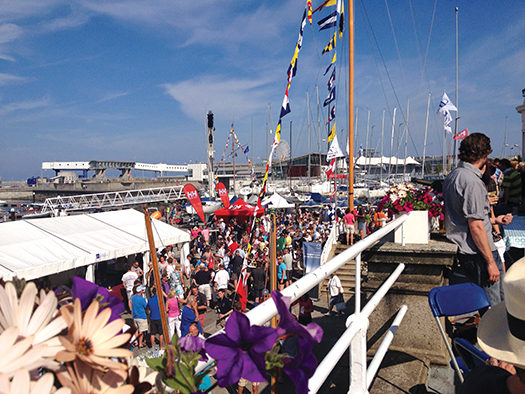
When the summer comes, the après sailing at the VDLR is world class. Photo: VDLR
Further reading:
Download the full entry list for Dun Laoghaire Regatta 2015 class by class below
Download the Sailing Instrcutions for Dun Laoghaire Regatta 2015 HERE
- Dun Laoghaire Regatta
- Volvo Dun Laoghaire Regatta
- Royal St George Yacht Club
- Royal Irish Yacht Club
- National Yacht Club
- ISORA
- Water Wags
- Royal Alfred Yacht Club
- yellowbrick
- GP 14
- Nigel Biggs
- George Sisk
- Annalise Murphy
- Half Tonners
- Tim Goodbody
- Mermaid
- Fool's Gold
- Dragon
- Irish National Sailing School
- Kenneth Rumball
- Dublin Bay
Royal St. George's Rupert Wins Sigma 33 Race to Greystones
#sigma33 – The Dublin Bay Sigma 33 fleet held their inaugural race to Greystones last Saturday for the "Night Cap Trophy". A fleet of six boats competed. The race was from Dublin Bay to the Mouldich and then to the Greystones Sailing Club finishing line.
After leaving the Bay in a 14–knot westerly and an ebb tide the fleet separated with Rupert (Dick & Philip Lovegrove) setting a course to seaward under spinnaker and the rest of the fleet sailing towards Bray. Approaching Molditch the wind died to 4 knots with Rupert holding a substantial lead on White Mischief (Tim Goodbody).
It was only a mile to the finish from the Molditch on a close Spinnaker reach. In the light conditions and an ebb tide sailing became difficult. White Mischief gradually caught up on Rupert and for the last 20 minutes sailed to the finish line overlapped. It was a very tight race and after 2 hrs 49 minutes each boat drew on all their sailing skills to hold their nerve in the tense moments as the two boats approached the finish neck and neck in the light conditions. In the end the laurels went to the crew of Rupert. The fleet retired to Greystones Sailing club for the prize giving.
1st – Scratch Rupert (Dick & Philip Lovegrove)
1st – (Echo) Leeuwin (Henry Leonard & Bobby Kerr)
#whitesails – The Royal St. George Team, captained by Howard Knott aboard Calypso, retained the inter-club team trophy in the KPMG sponsored, Royal St. George White Sails and Non-Spinnaker Team Challenge event sailed in the Club's home waters over the weekend.
Teams representing the Royal St. George, the Royal Irish and National Yacht Clubs fought it out over a series of three two and a half hour races in light but steady breezes, commencing with one 'round the cans' on Friday evening, then linking with the Royal Alfred Yacht Club Bloomsday Regatta, for Saturday's race (RAYC results here) where, with 18 boats, the White Sails and Non-Spinnaker fleet made up the largest class in the event. For that race, event Race Officer, Hal Bleakley set up a challenging course taking the fleet outside the perimeter of the course being used for the other fleets before heading out past the Muglins and into Killiney Bay to round the Shanganah Mark before returning for a West Pier finish.
On Sunday morning Martin Byrne set up his start line in the shadow of the Celebrity Silhouette Cruise Liner anchored off Dun Laoghaire. The course was similar to that on Saturday and Colin O'Brien of the George Team, in Spirit shot out in front and held his lead for the two hour race, fending off a late challenge from the Royal Irish YC Xerxes, to take line honours and secure the Trophy for the home team.
The 2016 running of the event will take place over the weekend 1st to 3rd. July, linked with the Royal St. George regatta.
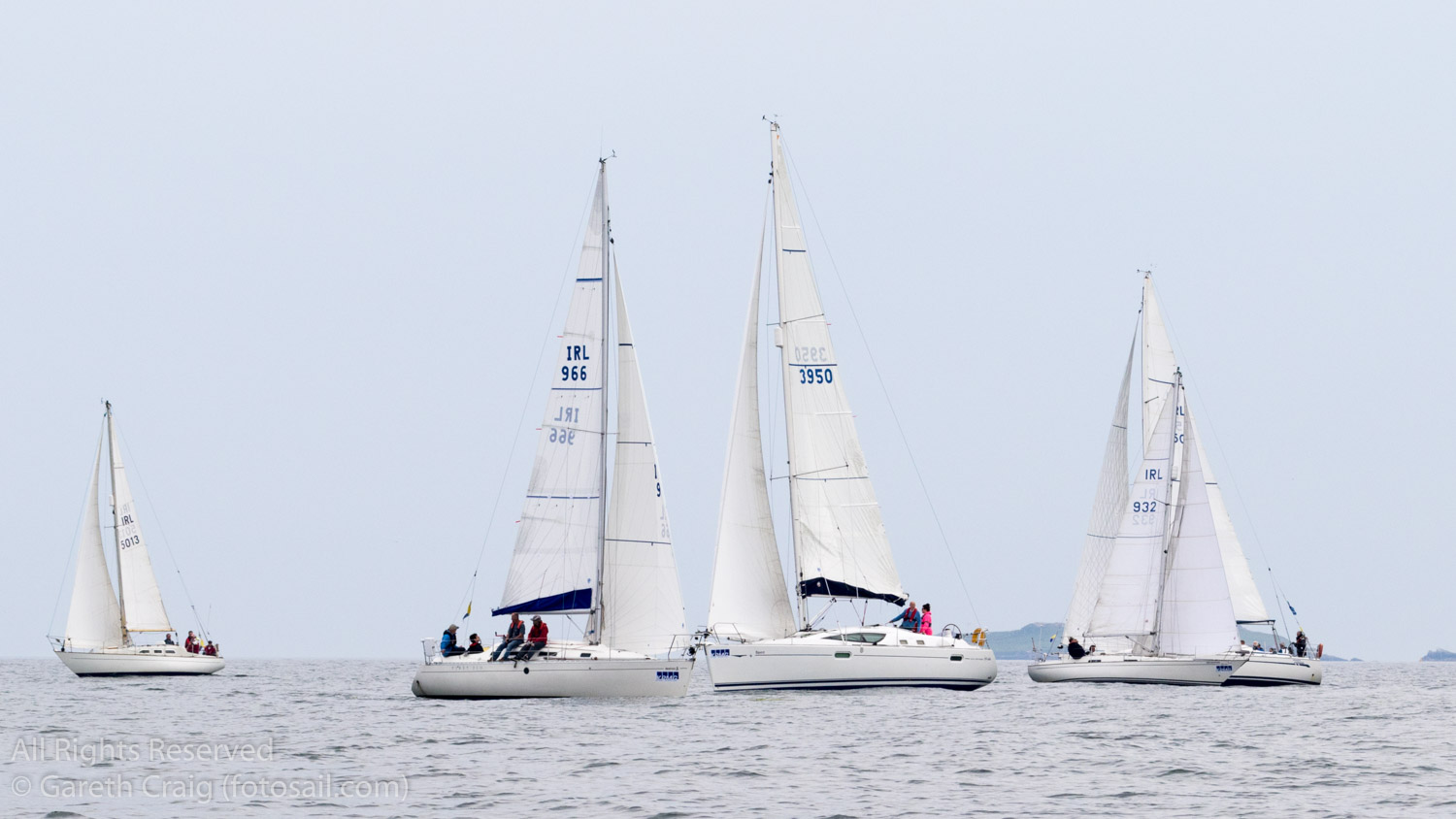


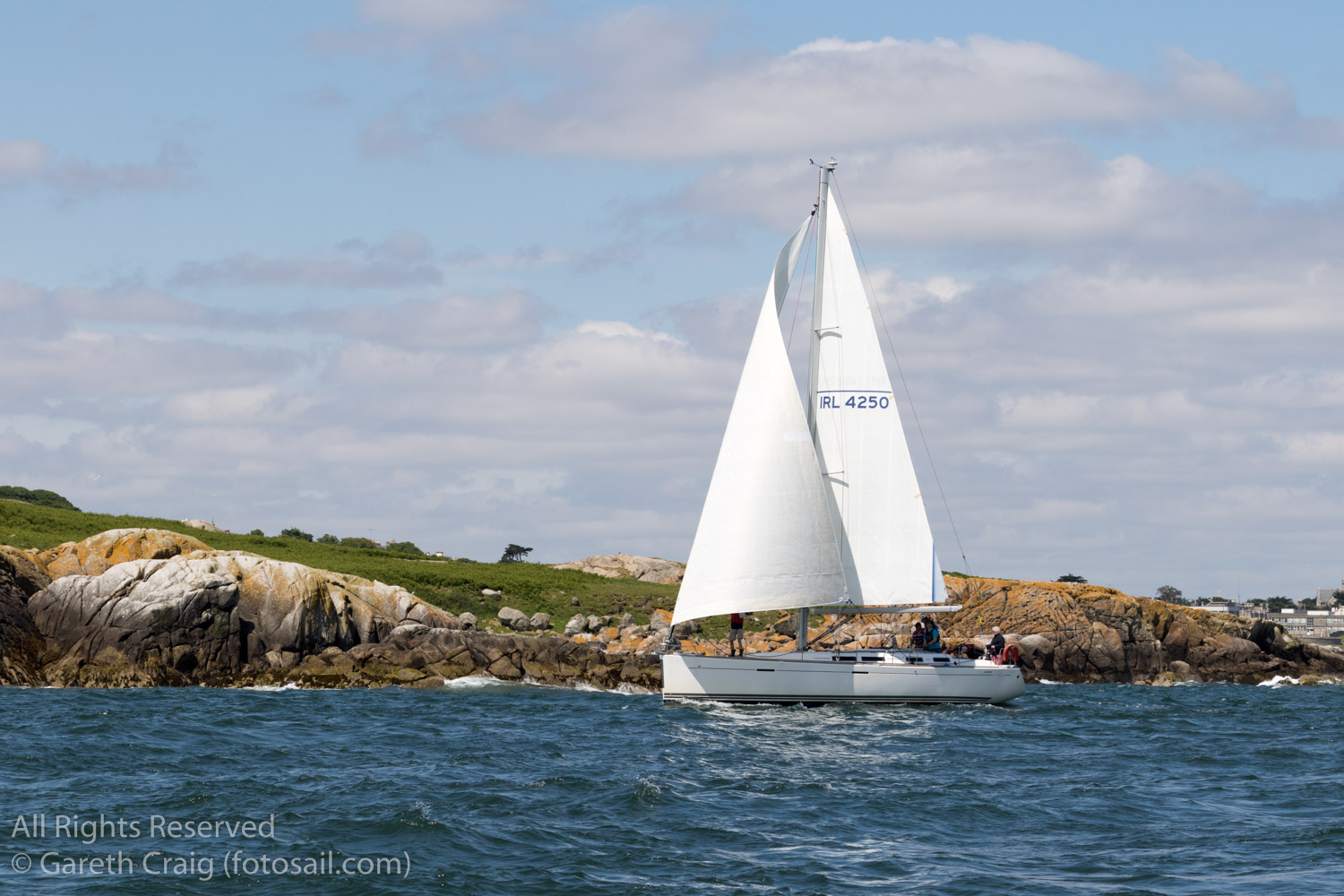
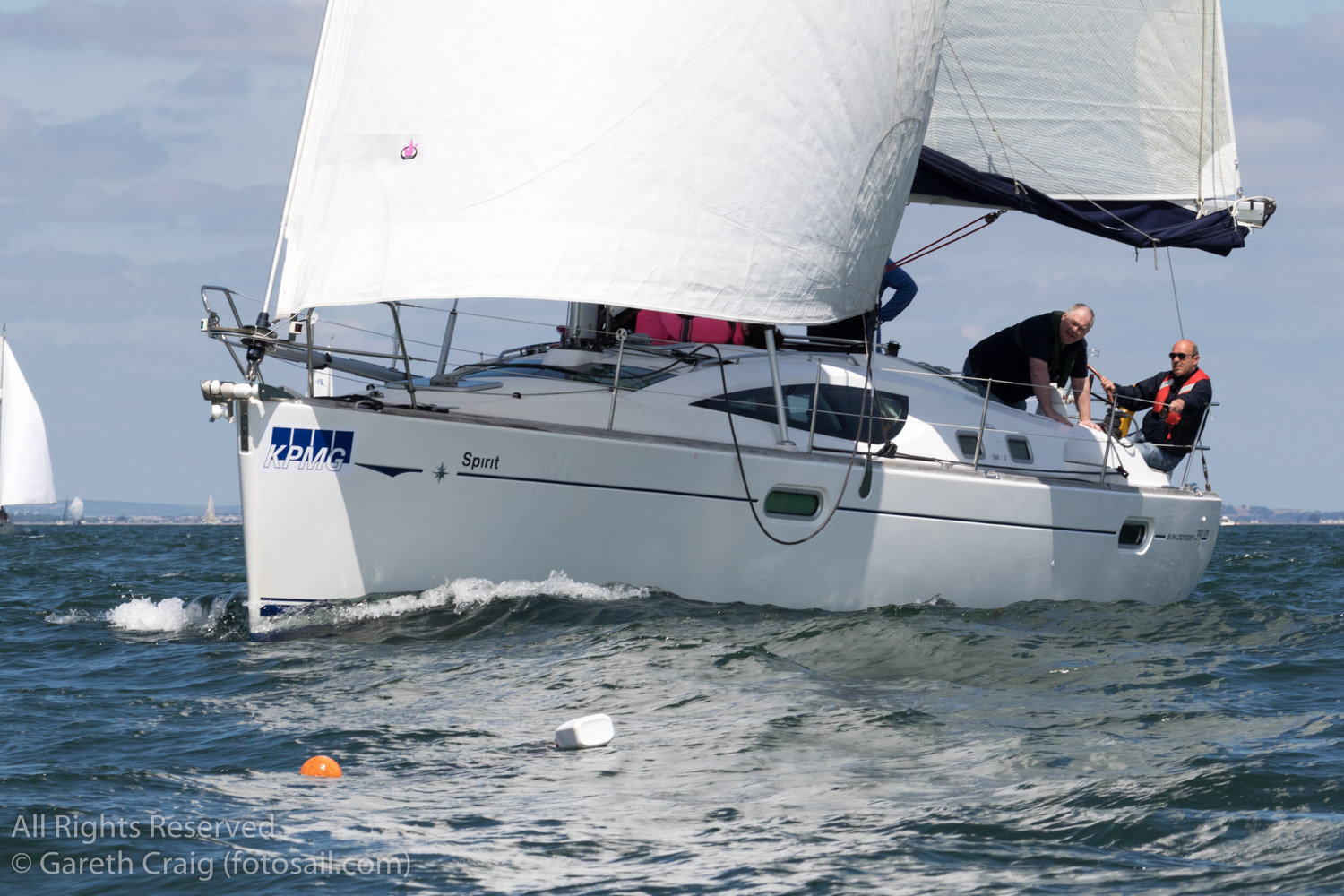

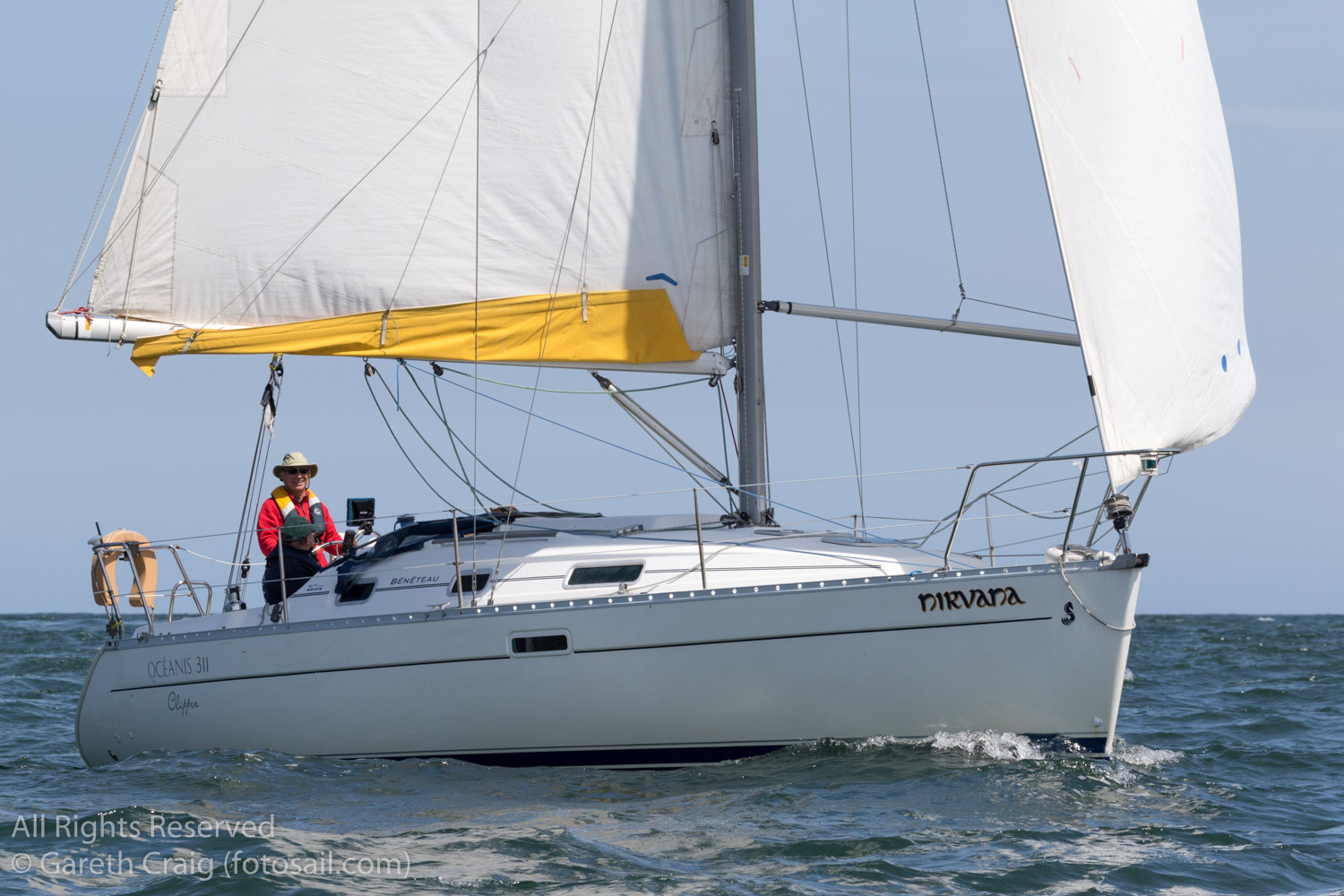
#ruffian23 – Diane skippered by Chris Helme of the host club was the winner of a 16–boat Ruffian 23 National Championhips at the Royal St. George Yacht Club at the weekend. Entries were largely Dublin Bay based but also included regular visitors from Belast Lough.
Race Officer Colin McMullen, assisted by Suzanne McGarry and the race team aboard Albanita, kicked off with a windward leeward race on Friday evening. Trevor Kirkpatrick, commodore of Carrickfergus Sailing Club sailing Carrageen, sailed a faultless race leading the 16 boat fleet from the start and getting the gun ahead of Frank Bradley's Ripples (DMYC), with holder Chris Helme's Diane II (RStGYC) 3rd.
A second race saw very light winds and just 8 boats finishing inside the 2 hour time limit. Again Carrageen took the gun with Rob Sastre's Paramour (NYC) in 2nd, and Chris Helme's Diane II finishing 3rd.
Three races were held on Saturday in a 12-15kt breeze. Diane II won the first race with Carrageen 2nd. The second race saw Carrageen getting her third gun of the series with Diane II finding herself the wrong side of a wind shift and finishing 11th. Saturday's final race resulted in a win for Diane II with Carrageen 2nd.
Going into the final day Carrageen had 5 points after discarding a 2nd – counting three 1sts and a 2nd. Diane II had 8 points after discarding her 11th – counting two 1sts and two 3rds. So Diane II needed two 1sts and needed Carrageen to finish worse than 2nd in both races in order for Diane II to retain the title. The 6th race saw Carrageen leading right up until the finish line where she was just pipped by Diane II and Crescendo (Lorcan Balfe NYC), with Carrageen finishing 3rd.
The last race saw Carrageen failing to recover from a poor start and finishing 7th, while Diane II climbed from 3rd place to 1st, getting her 4th gun of the series and winning the event on count-back from Carrageen.
Ruffian National Champs 2015 at the Royal St. George YC
1 Diane 2 3 3 1 [11] 1 1 1 10
2 Carrageen 1 1 2 1 2 3 [7] 10
3 Paramour [8] 2 6 4 8 4 2 26
4 Shannagh 6 5 5 [10] 3 6 3 28
5 Cresendo 9 4 4 [14] 5 2 6 30
6 Ruffles 7 [DNF] 7 2 4 8 4 32
7 Ripples 2 6 [9] 6 6 5 8 33
8 Bandit 5 [DNF] 3 7 7 7 9 38
9 Alias 4 [DNF] 8 5 9 9 5 40
10 Ruffage 12 8 [13] 8 12 10 10 60
11 Ruff Rider 10 [DNF] 12 3 14 13 11 63
12 Daisy 11 [DNF] 11 9 13 12 13 69
13 Riff Raff 15 [DNF] 10 13 11 11 15 75
14 Ruff Diamond 13 7 14 [DNF] 15 14 12 75
15 Different Drummer [DNS] DNS 15 12 10 DNS DNS 88
16 Ruff n Ready 14 [DNF] DNF DNF DNF 15 14 94
#dragon – Andrew Craig's Chimaera topped a 13–boat Dragon fleet to win the East Coast Championships at the Royal St. George Yacht Club at the weekend. Second on the Dublin Bay race track was Craig's club mate Phantom skippered by Neil Hegarty with Kinsale Yacht Club's Little Fella Cameron Good third overall.
Counting five top three results, including two races wins, Craig of the host club, emerged two points clear of Hegarty after discarding an eighth in the final sixth race. Full results downloadable below.
#rssprint – After watching the forecast fluctuate from a force 7 to a force 2 during the week, the fleet of RS400's were treated to a nice force 3-4 breeze and sunshine on the morning of the RS sprints at the Royal St. George Yacht Club. While numbers were smaller than usual at RS400 open events, the fleet felt more than big enough due to the tight start lines and short courses. The standard of the fleet also remained very high. Every boat in the fleet has had their time at the top including the newest members to the RS400 fleet, Barry McCartan and Connor Kinsella. They are current Fireball national champions and their entrance to the fleet is a shining example of what cyber peer-pressure can achieve. Also making a welcome appearance for the first time in the class was Olympian, Dan O'Grady.
The first 3 races saw the Ryan brothers dominate in tricky conditions with the wind beginning to drop and shift. Race 4 saw Sean Cleary and crew Luke Murphy gain a lead after a tough start. However, the breeze died off completely just before they rounded the leeward mark and the fleet grinded to a halt with the strong tide leading to the race being abandoned.
A steady southerly breeze kicked in 20 minutes later and the fleet began racing again. Races 4 and 5 saw the Ryan brothers take 2 more bullets. As the breeze continued to build, Ross McDonald took over at the front scoring firsts in the final 3 races.
Racing, as usual for the 400's was extremely tight in each and every race. Results were inconsistent for everyone showing how close the competition was. The Ryan brothers finished first. Second was McDonald/O'Grady and third was Paul McMahon and Laura Houlihan who showed great form throughout the event.
Next up is the RS Northerns in Carlingford Lough on the 27/28th of June where large numbers in all fleets is expected!






























































